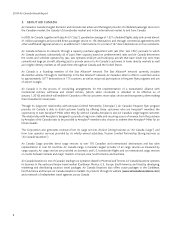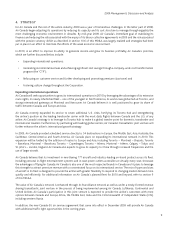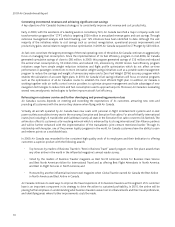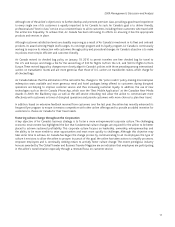Air Canada 2009 Annual Report Download - page 18
Download and view the complete annual report
Please find page 18 of the 2009 Air Canada annual report below. You can navigate through the pages in the report by either clicking on the pages listed below, or by using the keyword search tool below to find specific information within the annual report.2009 Air Canada Annual Report
18
Pacifi c with the re-introduction of the Toronto – Narita non-stop service with a Boeing 777 aircraft and additional
frequencies from Vancouver to China.
• A yield decline of 13.4% from the fourth quarter of 2008, which refl ected the continued weak economic environment,
continued fare discounting in an effort to stimulate traffi c and signifi cantly reduced fuel surcharges year-over-year.
Additional traffi c growth in the fourth quarter was accepted at lower yields in an attempt to fi ll the capacity growth,
which resulted in additional pressure placed on yields. Yield decreases were refl ected on all major Pacifi c services.
• A RASM decrease of 15.2% from the fourth quarter of 2008, which was largely due to the decline in yield but also
to the decrease in passenger load factor.
Other passenger revenues decreased 10.8% from the fourth quarter of 2008
Other passenger revenues (comprised of South Pacifi c, Caribbean, Mexico and South America) of $167 million in
the fourth quarter of 2009 decreased $20 million or 10.8% from the fourth quarter of 2008 due to reduced yields as
overall traffi c increased 3.3% year-over-year. Capacity growth on the South Pacifi c and Caribbean was mostly offset by
a capacity reduction on routes to Mexico. Components of the year-over-year change in fourth quarter other passenger
revenues included:
• A traffi c increase of 3.3% on the capacity reduction of 0.1%, which resulted in a passenger load factor improvement
of 2.6 percentage points versus the same period in 2008.
• A yield decline of 13.7% from the fourth quarter of 2008, which refl ected a weak economic environment,
increased fare discounting to stimulate traffi c, continued competitive pricing pressure and reduced fuel surcharges
year-over-year. Yield decreases were refl ected on all major services.
• A RASM decrease of 10.7% from the fourth quarter of 2008, which was due to the decline in yield.
Cargo revenues decreased 3% from the fourth quarter of 2008
Fourth quarter 2009 cargo revenues amounted to $110 million and were $3 million or 3% below the fourth quarter
of 2008. This represented a marked improvement compared to the much greater year-over-year reduction in revenues
recorded in the fi rst three quarters of 2009.
Cargo traffi c increased by 25% in the fourth quarter compared to the same period last year, on strong traffi c growth in Pacifi c
and Atlantic markets. This compared to the fi rst nine months of 2009 where non-freighter traffi c declined an average of
15% on a year-over-year basis. In 2008, however, weak economic conditions were already adversely affecting traffi c levels
during the fourth quarter. System cargo yield per revenue ton mile (RTM) was down 22% versus 2008 mainly due to lower
fuel surcharges, increased competitive pressure on rates in certain markets and, to a lesser extent, the unfavourable impact
of a stronger Canadian dollar on foreign denominated currencies.
Factors contributing to the year-over-year change in fourth quarter cargo revenues included:
• A decrease in domestic cargo revenues of 13% on a 6% traffi c increase and an 18% decline in yield per RTM.
Domestic capacity was down 5% versus the fourth quarter of 2008.
• A decrease in Atlantic revenues of 13% on 17% more traffi c and a 25% lower yield per RTM. Atlantic capacity was
up 7% versus the fourth quarter of 2008.
• An increase in Pacifi c revenues of 18% on 40% more traffi c and a 15% lower yield per RTM. Pacifi c capacity was up
7% versus the fourth quarter of 2008.
• A stronger Canadian dollar versus the fourth quarter of 2008 which had a negative impact on foreign currency
denominated revenues of $4 million in the fourth quarter of 2009.
























